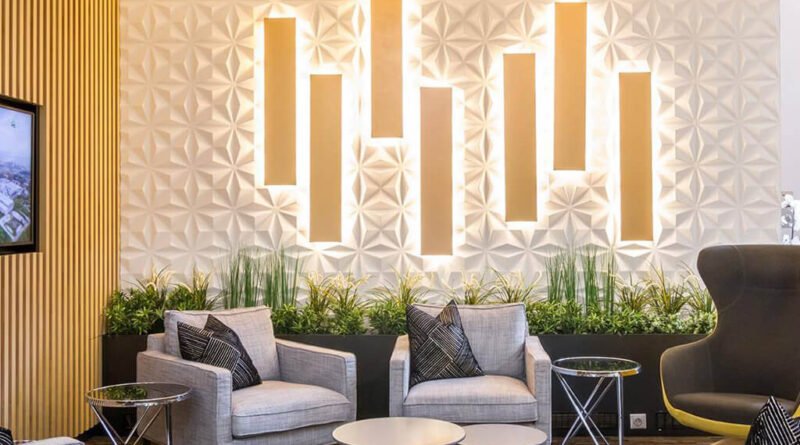10 Best Wall Light Design Ideas |Wall Hanging Lights
Hey there! Are you looking for the best Wall light Design to brighten up your house? Well, you are at the right place then. Wall light design plays an important role in improving the aesthetics and capability of indoor areas. They serve not only as a source of illumination but also as layout elements that contribute to the general atmosphere of a room. Depending on where you put them, how big they are, and what color they are, wall lights can provide ambient, accent, or task lighting in a room.
In current years, there has been a surge in modern wall light designs that mix form and function seamlessly. Let’s delve into the world of wall-light layout and discover the latest lighting trends to beautify your home.
Table of Contents
Wall Light Design: The Top 10 Ideas!
This list showcases the 10 best designs, exemplifying creativity, style, and functionality, offering transformative artistic statements and ideal lighting solutions for any setting. Choose the best wall light design for your living room for the best experience.
1. Chandelier Wall light Design
It is a form of decorative lighting fixture wherein, a chandelier wall light design is hung on the wall and features several branches or arms holding light sources. These light sources are frequently embellished with metal, glass, or crystals. Wall lights with chandeliers may bring a sense of sophistication and flair to any space, including living rooms, bedrooms, hallways, and staircases.
There are several types of Chandelier Wall light Designs like Empire chandeliers, Island chandeliers, Sputnik chandeliers, Shaded chandeliers, etc. The best thing about the Chandelier Wall light design is instead of producing harsh and direct light, it can reflect and refract the light in numerous ways, creating a warm and inviting ambiance, by hiding any holes or marks that earlier fixtures may have left behind, it can help protect the walls from harm. Moreover, to fit any taste or theme, it may provide a wide variety of designs, forms, sizes, materials, and styles.
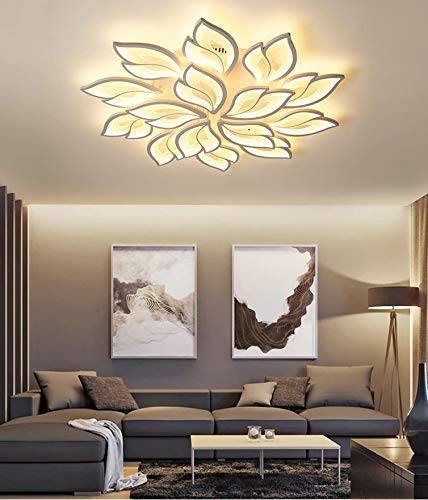
2. Classic Wall light Design
A conventional or vintage-styled wall-mounted decorative lighting fixture is known as a classic wall light design. Decorative elements like crystals, fabric shades, curves, and scrolls are common in classic wall lamps. They may transform any space, including living rooms, bedrooms, and corridors, into something elegant, warm, or romantic.
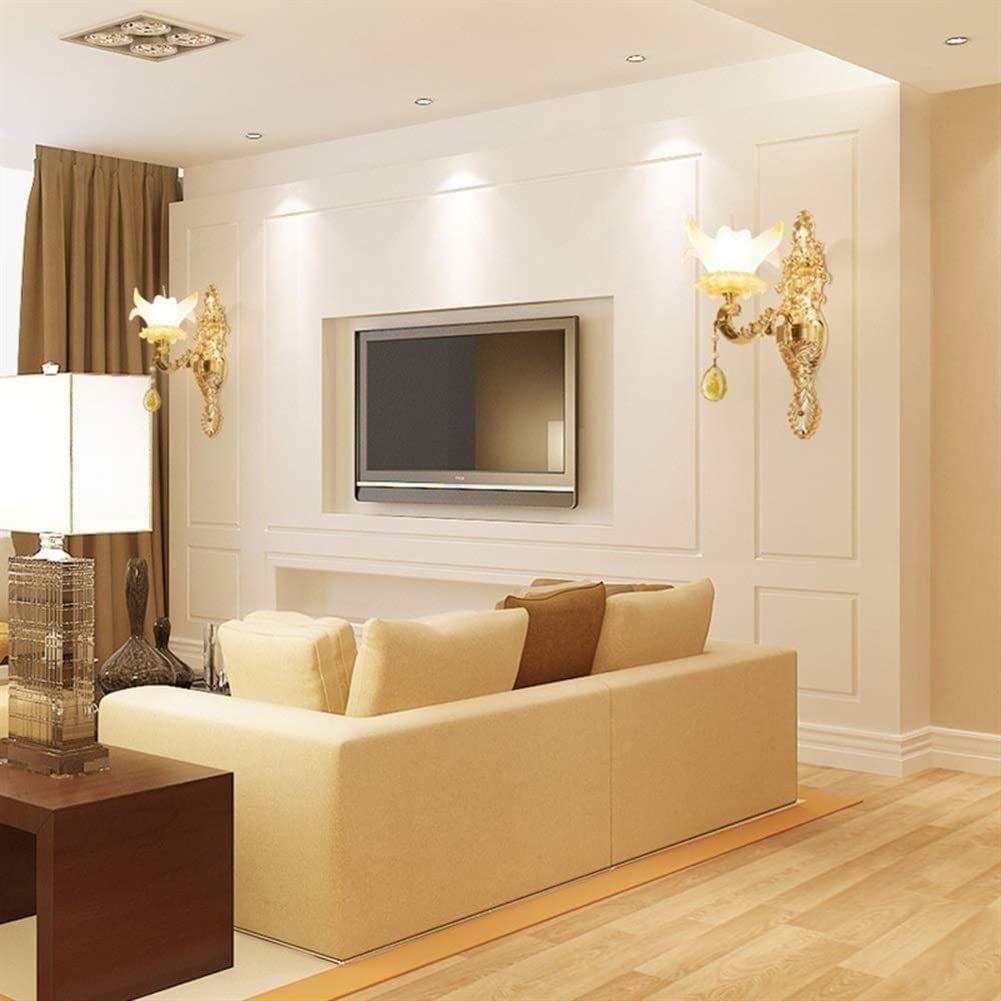
There are different types of classic wall lights, depending on the shape, size, material, and style of the fixture. Some of them are Novelty wall lights, Shaded wall lights, Empire wall lights, Candle wall lights, etc. Since it mounts on the wall and frees up floor and table space, it may enhance space efficiency, It can give focused lighting for comfort and functionality and provide diverse moods, activities, etc.
3. Neon Wall light Design
Gas-filled tubes are used in Neon wall light design to provide a vivid, multicolored glow. Because they can be formed into a wide variety of shapes and patterns, neon lights can be used to create visually striking signage or beautiful lighting shows.
You can consider Neon wall lights for your living room because they last longer and use less electricity than conventional incandescent bulbs. Moreover, many attractive designs and artwork can be lit with Neon lights. They are one of the best wall light designs for living rooms as well.
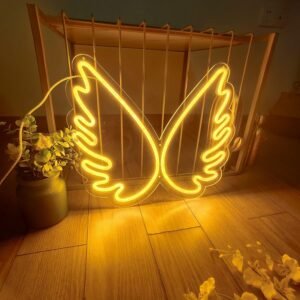
4. Modern Wall Light Design
Modern wall light design is characterized by modern-day and progressive procedures that cross beyond conventional lighting answers. These designs are conscious of mixing capability with aesthetic enchantment, often incorporating sleek lines, minimalistic paperwork, and current materials. Modern wall lighting fixtures contribute to the attractiveness of your living room through their effective lighting.
Depending on the light’s color, temperature, and intensity, modern wall lights can provide a variety of effects and moods in the living room. By simulating the natural light patterns of the day and night, they can also aid in the regulation of the circadian rhythm, i.e., the body’s natural cycle of sleep and wakefulness.
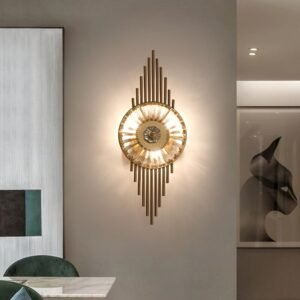
5. Uplighter Wall Light Design
The Uplighter wall light design shines light upward and toward the ceiling. It produces a gentle, ambient light that can improve a room’s ambiance and mood. They can draw attention to architectural details like arches, columns, or vaulted ceilings or they can be utilized to liven up boring walls.
You may opt for the Uplighter wall light design due to its provision of the impression that a space is larger and more airy by drawing the eye upward and creating a sense of height. Moreover, they can also produce a balanced and tiered lighting scheme and work well with other light sources like floor, table, or ceiling lights.
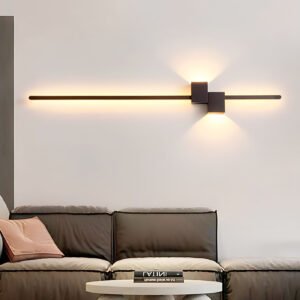
6. Art Deco Wall Light Design
Art Deco wall light design is a type of wall lighting that was prominent during the 1920s and 1930s. Its symmetrical patterns, vivid colors, and geometric shapes capture the artistic and cultural trends of the day. In every space, Art Deco Wall Light may produce a wealthy and elegant effect in your living room.
You can light up your living room with any type of Art Deco wall light like Ceramic wall lights with ceramic frames that are molded into various shapes, Wood wall lights with carved wooden frames portraying beautiful patterns, or Chrome wall lights possessing shiny metal frames that matches the color of the living room’s wall. All these ensure artistic and cultural essence in your room.
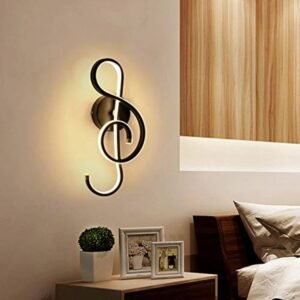
7. Bohemian Wall Light Design
The Bohemian wall light design depicts an eccentric, eclectic, and artistic way of living. It draws inspiration from several global cultures like Morocco, India, and Turkey. Materials like feathers, ceramics, wood, beads, fringe, rope, and rustic metals can all be used in bohemian wall lights.
If you are a person who loves historic art, then you may consider this Bohemian wall light as these lights represent the influences and customs of different countries and peoples around the world, it can give your home a little bit of history and culture. Moreover, you may mix and combine different colors, patterns, and textures to fit your mood and taste, it can reflect your personality and creativity.
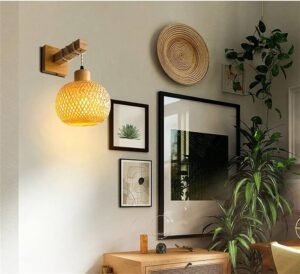
8. Column Wall Light Design
Column Wall light Design is a kind of interior lighting that highlights pillars or columns in a space by using wall-mounted lights. This can draw attention to the space’s architectural characteristics and produce a dramatic, elegant impression. You can create a variety of lighting strictures with the Column wall light pattern using Scones, and cladding, and even try Up and Down lighting. One of the unique methods of Column wall light pattern is the Garland technique wrapping garlands made of ribbons, flowers, leaves, vines, or other materials around the column to create a seasonal or themed effect for special events like weddings, parties, or holidays.
Column wall lights can bring attention to the column and its design by establishing a focal point or visual appeal in the space. Besides, it can help improve the room’s visual attractiveness and give it a more upscale, sophisticated look and also add more lighting to your living room, particularly in gloomy or dark locations.
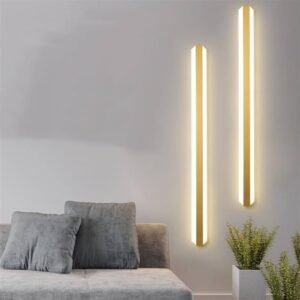
9. Under Shelf Wall Light Design
Under Shelf Wall Light Design is nothing but the positioning of lighting fixtures beneath shelves or cabinets to give the countertop or workplace below focused illumination. This becomes a very useful one increasing the visibility for a variety of jobs, particularly in the kitchen where it can be useful for cutting, cooking, and reading recipes. A creative and adaptable way to use shelves as more than just storage spaces is with Under Shelf Wall Light Design. They can be made into lovely and useful elements that improve the interior decor and atmosphere of the space by utilizing various methods and concepts.
The Under wall lighting can also help enhance the room’s overall aesthetics by adding a layer of ambient lighting, which can highlight accent pieces, showcase displays, or create a warm and inviting ambiance. Also, under-shelf wall lights can save energy, particularly if they make use of long-lasting, low-voltage LED lights.
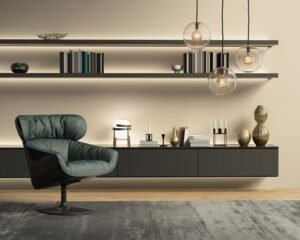
10. Industrial Wall Light Design
The look of abandoned factories, warehouses, and other industrial areas serves as the inspiration for the lighting design known as “Industrial wall light design.” Usually, it has wire cages, exposed bulbs, metal components, and antique finishes. Yet, it is constructed from rigid, long-lasting materials that need little upkeep and may endure a long time.
Moreover, there are so many advantages to Industrial wall lighting like it produces a distinctive and striking appearance that goes well with a variety of interior design motifs, including nautical, rustic, and modern. It offers brilliant illumination that can help improve the atmosphere and usability of the area.

Light up Your Space with Wall Hangings
Wall hanging lights, also known as wall sconces, are versatile fixtures that can dramatically enhance the ambiance and functionality of any room. These fixtures offer a myriad of benefits, whether you’re seeking a touch of elegance in your living room or better task lighting in your study. A wall hanging light is an excellent addition to any home decor repertoire for both its aesthetic appeal and its practical advantages.
The appeal of aesthetics
The primary reason homeowners choose wall hanging lights is their aesthetic appeal. These fixtures come in a wide range of styles, from sleek modern designs to vintage-inspired lanterns. A wall hanging light can serve as a focal point or complement existing decor, bringing depth and visual interest to walls that would otherwise seem bare. There is a wall hanging light that matches any interior design scheme, whether it is brass, glass, or wood.
Placement versatility
The placement of wall hanging lights is greater than that of ceiling-mounted lights. Their versatility makes them ideal for both residential and commercial spaces where adjustable lighting is desired. They can be installed at varying heights to create specific lighting effects or to highlight architectural features such as artwork or accent walls.
Solutions for functional lighting
Depending on their design and placement, wall hanging lights provide functional benefits, including ambient, task, or accent lighting. In bedrooms, they can serve as reading lights beside the bed, while in hallways and entranceways, they can provide a welcoming glow that enhances safety and visibility.
Design that saves space
In addition to their space-saving design, wall hanging lights also offer a variety of advantages. Unlike floor lamps or table lamps, wall sconces free up valuable space. Because of this, they are particularly suitable for small areas or areas where floor space is limited but additional lighting is needed.
Installation and maintenance are easy
Most wall hanging lights are easy to install, especially if the electrical wiring is already present. Several models come with plug-in options so installation is easy with basic tools. In addition, maintenance is usually easy, requiring only periodic dusting or bulb replacement.
How to Choose the Right Wall Hanging Lights
It is important to consider factors such as the room’s decor style, the lighting’s intended purpose, and the fixture’s size in relation to the wall space when choosing wall hanging lights. Make sure the color temperature and light output are compatible with your needs—warm colors for cosy spaces and cooler colors for task-oriented spaces.
1. Take the purpose and style of the room into account
When choosing wall hanging lights, you need to consider the room’s purpose and existing decor style first. Different rooms require different lighting atmospheres. For example, softer, warmer-toned lights may be best in a living room or bedroom that emphasizes relaxation and ambiance. However, brighter lights with cooler tones may be more appropriate in areas like a study or kitchen that require task lighting.
The style of the wall hanging lights should also harmonize with the room’s decor. Modern rooms might benefit from sleek, minimalist sconces with clean lines and metallic finishes. A traditional or vintage-inspired room could benefit from ornate sconces featuring brass or antique finishes. By matching the style, the lights enhance the overall aesthetic appeal.
2. Determine the lighting requirements
You should choose wall hanging lights based on the specific lighting requirements of your room. You should decide whether the lights will serve as ambient lighting, accent lighting, or task lighting. Ambient lighting illuminates the room as a whole, while accent lighting emphasizes specific features, such as artwork or architectural details. Task lighting is used beside a bed or over a desk to provide functionality and visibility.
Depending on the room’s layout and function, you may opt for adjustable sconces that allow you to direct light where needed, or fixed-position sconces that provide consistent illumination in a particular area. By understanding these requirements, wall hanging lights can contribute effectively to the comfort and usability of a room.
3. The size and placement of the sign should be considered
Wall hanging lights must be sized according to the space and other elements in the room. A sconce that is too large or too small may not provide enough light or visual impact in a larger space, while one that is too small can overwhelm. Consider the proportion of the sconces in relation to nearby furniture or architectural features by measuring the available wall space.
Sconces should be placed at eye level (about 5 to 6 feet from the floor) to distribute light evenly across the room regardless of their intended function. The best height to install sconces depends on their intended function. It is important to adjust the placement of accent or task lights so that they direct the light precisely where it is needed without creating glare or shadows.
4. Choose the right type and wattage of light bulb
In wall hanging lights, the type of light bulb used affects both the quality of light and the energy efficiency. Choose between incandescent, LED, and CFL bulbs according to factors such as color temperature, energy consumption, and lifespan.
In comparison to newer technologies, incandescent bulbs provide warm, inviting light, but they are less energy-efficient.
They are energy-efficient, durable, and available in a range of color temperatures, making them ideal for both ambient and task lighting.
It may take time for CFL bulbs to reach full brightness and they may not be as widely compatible with dimmers.
Make sure the sconces provide adequate illumination without exceeding recommended fixture limits by considering their desired brightness (measured in lumens) and wattage compatibility.
5. The budget and installation considerations
Finally, consider your budget when purchasing and installing wall hanging lights. Prices vary greatly depending on the design, materials, and brand. Also consider additional costs such as installation fees if professional installation is needed.
If opting for DIY installation, ensure the sconces come with clear installation instructions and necessary hardware. Plug-in models are available for easy installation without electrical wiring. When hardwired, consult a qualified electrician to ensure safety and compliance with local building codes.
FAQ
1. How do different wall light designs impact the overall ambiance and mood of a room beyond just providing illumination?
Different wall lighting can influence the atmosphere by focusing light, creating visual interest, and contributing to the room’s overall aesthetic.
2. What are some innovative ways to integrate wall lights into interior design schemes, such as combining them with architectural features or using them to create focal points?
Integrating wall lights creatively requires drawing attention to architectural elements, using them as focal points, and experimenting with various installation methods to deliver them the interior design process is effective.
Emerging technologies such as LED lighting and sustainable design features such as energy-efficient fixtures are being incorporated into modern wall lighting designs to promote environmental sustainability and reduce energy consumption.

